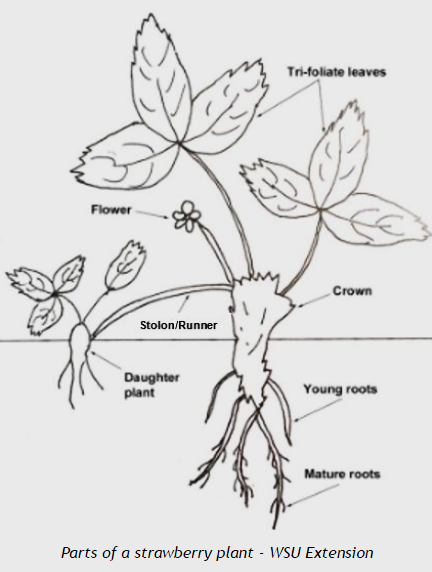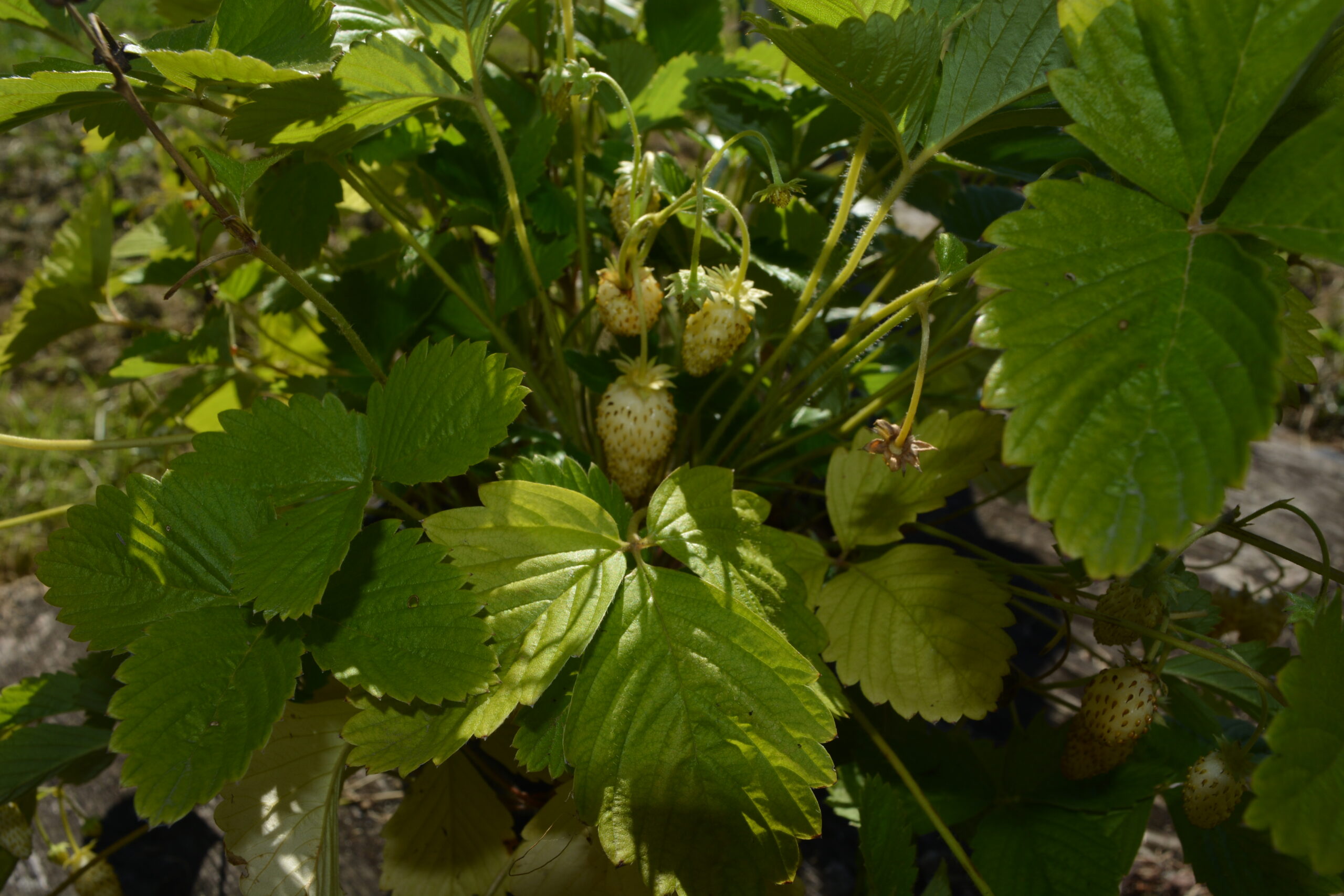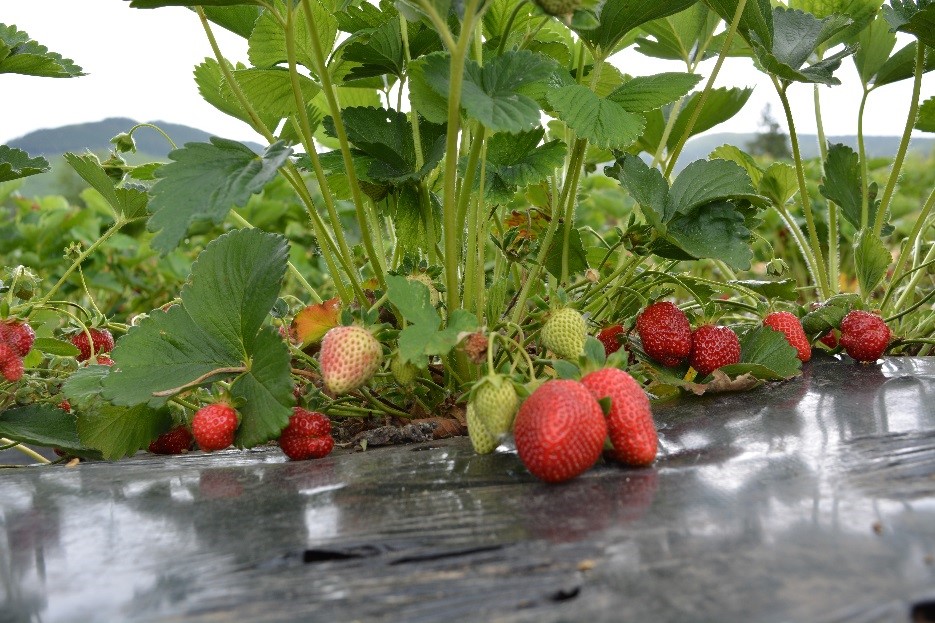growing strawberries
Site Selection
Strawberries prefer sandy, well-drained soil and full sun. Remove all weeds, and work in compost before planting. Strawberries need at least 6-8 hours of sun Spring through Fall to produce quality fruit. Plant dormant plants late winter through mid-spring. Trim the roots to 4″-5” and set so that the crown is at soil level. Do not bury the short, thickened stem or crown too deep!
Strawberries need soil moisture to thrive. The most crucial times are before and during harvest, and in late summer and early fall when June bearers are forming flower buds for next year’s fruit. Drip or soaker hose irrigation is preferred to avoid fruit rot. Control weeds to reduce competition in the bed. Mulching can help suppress weeds, conserve moisture, and keep the berries off the soil.

Types
Two types are widely grown in home gardens. June Bearing (Main Crop) types bear one crop of berries in June or early July. Day neutral (Everbearing) types produce both flowers and fruit from June through September or October.
June Bearing or Main Crop
June bearers or Main Crop should be planted 15″-24″ apart in rows spaced 36″-42″. Stolons/runners (horizontal stems that will root and create new daughter plants) will fill the spaces between to form a matted row 14″-18″ wide. Remove the first season’s flowers by cutting or pinching them off to encourage runner formation and good root establishment. Pin the runners in desired locations to fill the row. Do not let daughter plants root closer than 6″. Any runners that form after late August should be removed.
The second season, the plants can be allowed to bear a full crop. After they finish fruiting, cut or mow the leaves to stimulate vigorous growth. Dig up and replant rooted runners to fill gaps in the rows. At this time, lightly fertilize the bed.
Everbearing or Day Neutral
Day neutral varieties should be planted 10″-18″ apart in rows spaced 30″-36″. They produce few runners compared to June bearers. In the closer spacing, remove all runners throughout the season; in wider plantings, allow one runner between each plant. Remove the first blossoms to encourage root development. Flowers appearing after mid-June can be allowed to form fruit. Fertilize day neutral varieties in late summer.


Pests and Diseases
In most home gardens, the strawberry bed will need complete replanting every 3-6 years due to virus infection. The leaves can show dwarfing and cupping if virus infected. You will know it is time for a new bed when berry production declines. Some of the newer cultivars are longer lived, needing to be replanted less often. Always replant with certified virus-free crowns.
Gray Mold: a fungal disease that will turn berries fuzzy gray. Control by picking and tossing affected berries and raising the berries on mulch so they do not touch the soil.
Common Leaf Spot: Another fungal disease that can overwinter on old foliage and infect new leaves in spring. Mowing or cutting the foliage of June bearer varieties after harvest can help prevent and control the disease. Drip irrigation rather than overhead also helps prevent infection.
Shallot and Strawberry Aphids: Common pests on strawberries that can spread viruses to the plants, eventually causing them to decline. Avoid overfertilizing plants; lush foliage can attract aphids. If aphids appear, wash off with a strong jet of water or use horticultural soap.
Slugs and Snails: Cause damage by feeding on both foliage and fruit. Remove rocks, tall grass, and weeds near plants. Hand pick when possible or use iron-phosphate baits around plants.
Spotted Wing Drosophila: Adult flies lay their eggs in ripening fruit; the larvae hatch and eat their way around inside the berry. Spinosad and neem extract insecticides can provide some control.
Cutworms: A larva of a moth that live just under the soil surface and emerge at night to feed on foliage, flowers, buds and fruit. Removing grass and weeds near the strawberry beds can help decrease their populations. For larger infestations, use Bacillius thuringiensis (Bt) to control. The larvae will need to feed on sprayed foliage for it to be effective, so repeat applications might be necessary.

